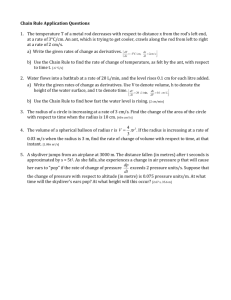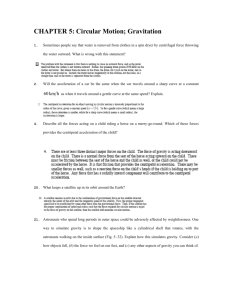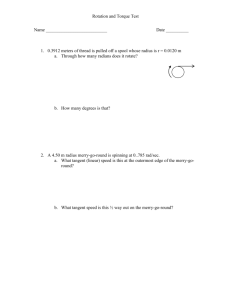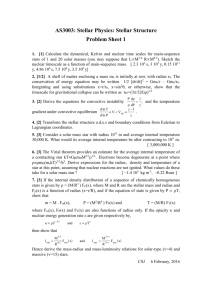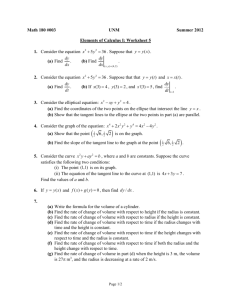Name of Model
advertisement
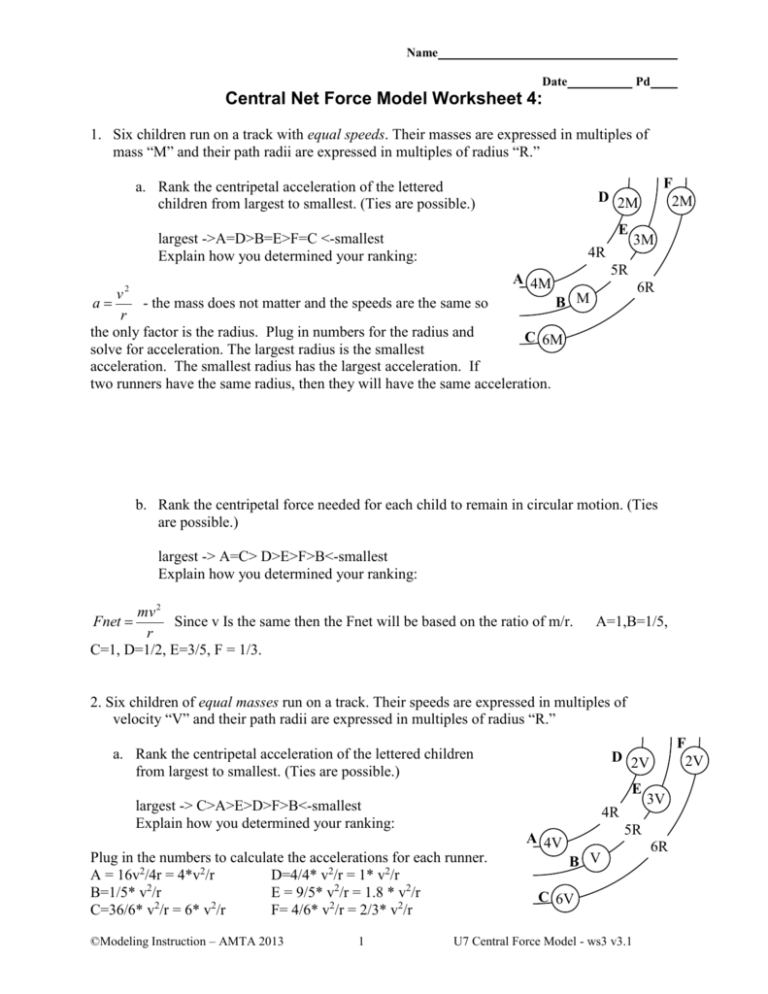
Name Date Pd Central Net Force Model Worksheet 4: 1. Six children run on a track with equal speeds. Their masses are expressed in multiples of mass “M” and their path radii are expressed in multiples of radius “R.” a. Rank the centripetal acceleration of the lettered children from largest to smallest. (Ties are possible.) F 2M D 2M E largest ->A=D>B=E>F=C <-smallest Explain how you determined your ranking: 3M 4R 5R A 4M 6R v2 B M - the mass does not matter and the speeds are the same so r the only factor is the radius. Plug in numbers for the radius and C 6M solve for acceleration. The largest radius is the smallest acceleration. The smallest radius has the largest acceleration. If two runners have the same radius, then they will have the same acceleration. a b. Rank the centripetal force needed for each child to remain in circular motion. (Ties are possible.) largest -> A=C> D>E>F>B<-smallest Explain how you determined your ranking: mv 2 Since v Is the same then the Fnet will be based on the ratio of m/r. r C=1, D=1/2, E=3/5, F = 1/3. Fnet A=1,B=1/5, 2. Six children of equal masses run on a track. Their speeds are expressed in multiples of velocity “V” and their path radii are expressed in multiples of radius “R.” a. Rank the centripetal acceleration of the lettered children from largest to smallest. (Ties are possible.) E largest -> C>A>E>D>F>B<-smallest Explain how you determined your ranking: 4R ©Modeling Instruction – AMTA 2013 1 3V 5R A 4V Plug in the numbers to calculate the accelerations for each runner. A = 16v2/4r = 4*v2/r D=4/4* v2/r = 1* v2/r 2 B=1/5* v /r E = 9/5* v2/r = 1.8 * v2/r C=36/6* v2/r = 6* v2/r F= 4/6* v2/r = 2/3* v2/r F 2V D 2V B V C 6V U7 Central Force Model - ws3 v3.1 6R b. Rank the centripetal force needed for each child to remain in circular motion. (Ties are possible.) largest -> C>A>E>D>F>B <-smallest Explain how you determined your ranking: Since all the masses are the same the Fnet and acceleration are directly related. The greatest acceleration will be the greatest Fnet. The smallest acceleration will be the smallest Fnet. ©Modeling Instruction – AMTA 2013 2 U7 Central Force Model - ws3 v3.1 3. Rollercoasters use a hill for riders to gain speed followed by an upside down loop. The loops are designed with large radius bottoms and small radius tops, and such a shape is called a clothoid. Answer the following questions in order to find out why the clothoid is used. The speed of the rollercoaster is 22 m/s at the bottom of the loop and 8 m/s at the top of the loop. a. Use quantitative force diagrams to determine the size of the force on the rider by the seat at the top and bottom of the loop. mv 2 Fnet r Fseat r Fearth r mv 2 r mv 2 Fseat r mg r Use this equation and plug in numbers for bother the top situation and bottom situation. Bottom: Fseat-rider = 58,400N upward direction Top: Fseat-rider =2800N downward direction b. Now suppose the rollercoaster had been designed with the small 5 meter radius at the bottom and the large 10 meter radius at the top. Use quantitative force diagrams to determine the size of the force on the rider by the seat at the top and bottom of the loop. ©Modeling Instruction – AMTA 2013 3 U7 Central Force Model - ws3 v3.1 Fnet mv 2 r Fseat r Fearth r mv 2 r mv 2 r Use this equation and plug in numbers for bother the top situation and bottom situation. Top: Fseat-rider = 106800N upward direction Bottom: Fseat-rider =3600N upward force Fseat r mg c. Why is the clothoid shape used in rollercoasters? ©Modeling Instruction – AMTA 2013 4 U7 Central Force Model - ws3 v3.1 4. 80 kg Tarzan grabs a vine to swing to another tree. a. As Tarzan swings from point A to point B, describe qualitatively how the tension in the vine changes and why. As he is swinging, the net force is towards the center of the circle. His weight never changes so the force down will always be the same. On the other hand, the force of the vine on Tarzan will continually increase until the maximum at the bottom of the swing when the net force is straight up, and the force of the vine on Tarzan is the greatest. 8m A 2m BC b. At point B he is swinging at 7 m/s and the vine is 8 meters long. How hard does he have to hang on to the vine to keep from slipping off? Use equation for #3: Fvine-Tarzan (which is equal to the F tarzan - vine)=1290N c. A moment later, at point C, the vine catches on a branch, reducing the radius of the swing to 2 m. If Tarzan is still traveling at 7 m/s, how hard does he now have to hold on to the vine? Fvine-Tarzan = 2760N ©Modeling Instruction – AMTA 2013 5 U7 Central Force Model - ws3 v3.1 d. If Tarzan slips off at point C what will be the path he takes? (Sketch the path on the diagram.) How does this path differ from circular motion? Perpendicular from the radius. ©Modeling Instruction – AMTA 2013 6 U7 Central Force Model - ws3 v3.1 5. A carnival clown rides a motorcycle down a ramp and around a “loop-the-loop.” If the loop has a radius of 18 m, what is the slowest speed the rider can have at the top of the loop without falling off the track? Fnet=Fearth-rider=mg mv 2 Fnet r mv 2 mg r 2 v g r V= 13.4m/s 6. A 75 kg pilot flies a plane in a loop. At the top of the loop, where the plane is completely upside-down the pilot feels no forces from the seat or the seat belts. (The pilot is “weightless.”) If the plane’s speed is 120 m/s, what is the radius of the loop? Fnet = Fearth-pilot See equation above R = 1440m 7. A 615 kg race car completes one lap at constant speed in 14.3 sec around a circular track with a radius of 50 meters. a. Calculate the acceleration of the car. 2r v v= 22m/s T v2 a a = 9.68m/s/s r b. Calculate the force the track must exert on the car to allow the car to travel in a circle. Fnet ma Fnet= 5953.2N 8. **Challenge question** Calculate the maximum speed a car can successfully complete an 80 meter radius turn on a flat road if the coefficient of friction is .40. (****notice mass is not given. You do not need it!) ©Modeling Instruction – AMTA 2013 7 U7 Central Force Model - ws3 v3.1 9. Use the following diagram to answer the questions below a. At the top of the first hill of the rollercoaster, point “a,” a 60 kg passenger feels as if she “weighs” 500 N. Explain which force provides the sensation of weight. How fast is the rollercoaster going over the 3 m radius hilltop to create this sensation? Draw a quantitative force diagram for the situation. The force of the surface pushing up give the sensation of being ‘lighter’ or ‘heavier’. Fnet mv 2 r Fs p Fe p mv 2 r 500 N 600 N 60kg v 2 3m v 2.2m / s b. At point “b” the rollercoaster has reached a speed of 28 m/s. How large must the radius of the valley be so that a 100 kg rider will experience a normal force of five times their weight (5 G’s)? Draw a quantitative force diagram for the situation. c. At point “c” a 70 kg rider is traveling at 20 m/s in a 7-meter radius curve. Draw a quantitative force diagram for the rider. d. At point “d” a 40 kg child is upside-down at the top of the loop. How fast would the train have to pass through the 4-meter radius ©Modeling Instruction – AMTA 2013 8 U7 Central Force Model - ws3 v3.1 curve to produce a 200 N downward normal force on the child? Draw a quantitative force diagram for the child. e. Exiting the loop at valley “e” the 2000 kg rollercoaster exerts a downward normal force on the track of 90,000 N. The track radius is 130 meters. Draw a quantitative force diagram for the rollercoaster train. f. At the top of hill “f” the rollercoaster crests the 5-meter radius curve at 6 m/s. Draw a quantitative force diagram for a 60 kg passenger. How many G’s would any passenger feel at the top of the hill? ©Modeling Instruction – AMTA 2013 9 U7 Central Force Model - ws3 v3.1

